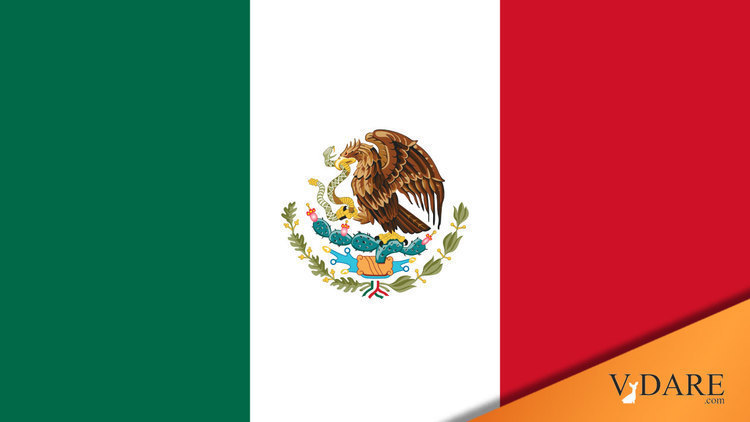22 (!) Years Earlier by Steve Sailer: Importing Mexico’s Worsening Racial Inequality and America’s Imported Caste System
From the New York Times news section:
Echoes of Latin American Racism Reverberate in the U.S.
Disparaging remarks about Oaxacans from the Los Angeles City Council president shocked a city that prides itself on tolerance. But they highlighted a history of racism within the Latino community.
By Miriam Jordan
Oct. 14, 2022
LOS ANGELES — Ivan Vasquez arrived in Los Angeles in 1996, a teenager who had crossed the border to find work and improve the lot of his family in Mexico. As a newbie washing dishes in restaurants, the young man from the majority Indigenous state of Oaxaca was often called “Oaxaquita,” or Little Oaxacan, by other Mexicans because of his deep tan skin and diminutive stature.
I don’t think my readers will have much trouble making sense of this NYT article because I’ve been covering the complexities of Mexican physical and genetic anthropology since 2000. But the NYT’s restrictions on how it gingerly talks about racial anthropology (which is increasingly considered to be, ipso facto, “pseudoscience”) is likely to leave most of its subscribers intellectually checked out from grasping much from this long article.
After all, as we all know, Race Doesn’t Exist, so what in the world is this article about?
First, not even I was aware that the new, official Woke term for immigrants who are New World Indians by race is now “Indigenous.” But the term “Indigenous” appears 19 times in this article, while the term “Indian” does not appear once.
The word “indio” appears once and its use by Mexican-Americans is treated as an ethnic slur, which I doubt it is considered to be in Mexico, rather than as a statement of fact.
“Growing up, we heard a lot of belittling, derogatory terms, like “Oaxaquita” and “indio,” he said.
Americans have a hard time understanding what in the world Mexicans are talking about because we’ve more or less banned the terms Mexicans actually use in respectable discourse, like “indio” and “mestizo,” as obvious ethnic slurs.
The concept of “Indigenous immigrants” is an obviously stupid oxymoron. Mesoamerican Indians are not indigenous to the United States, as American Indians will tell you.
Moreover, in this world, lots of peoples are indigenous to lots of places, so why one set of indigenous people should get the racial name “Indigenous” no matter where they go in the world is not obvious.
Of course, with the growth of Asian Indians in the United States, who tend to get their names into the New York Times a lot more these days than do Latin American Indians, Columbus’s Mistake is getting more confusing.
They are indigenous to the New World in general, so why not call them New World Indians? (I gather there is some Woke objection to the terms Old World and New World in terms of who gets to be centered, but of course humanity evolved in the Old World, so calling the Old World the Old World would appear to be scientifically reasonable.) Or why not Western Hemisphere Indians?
Scholars long ago came up with the self-evident portmanteau neologism “Amerindian,” which was fashionable among progressive academics when I was young. It hasn’t been cancelled—it continues to be used now and then in the culture columns of the NYT—but it almost never appears in the news sections. Evidently, it is not part of the NYT news section stylebook, for unexplained reasons.
Why not use all of these terms to de-baffle readers?
Another problem for New York Times readers is that they are up in arms at the mestizo Los Angeles councilwoman Nury Martinez describing the newcomer Indians from Oaxaca in the south of Mexico with the stereotype of “short,” but of course the stereotype is, statistically, true on average. But of course, NYT subscribers have to be indoctrinated to believe “stereotypes,” by definition, can’t be true. So, it’s all a minefield for NYT reporters.
It’s also factually puzzling, since in the U.S. there is not much of a stereotype of American Indians being short. If anything, the old stereotype in the U.S. was that Indians tend to be big, like Jim Thorpe and Chief in One Flew Over the Cuckoo’s Nest. That’s because there is a gradient within the Amerindian race, with the tallest Indians probably being the Blackfoots around the Canadian border and the shortest being in Guatemala. But that’s “race science,” which is by definition pseudoscience, so are we even talking about this?
My guess is that all that most NYT subscribers are conceptually equipped to take away from this article is that Somebody Was Not Nice!
iSteve commenter Faraday’s Bobcat notes:
NYT discovered Latino racism right about the same time Latinos discovered the GOP.













